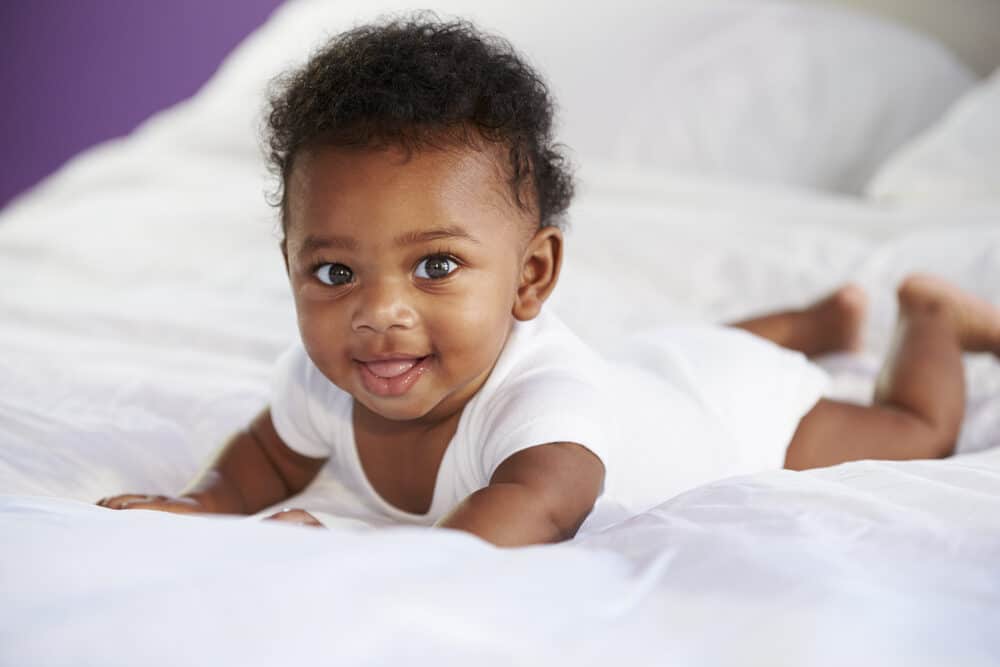
Prenatal ultrasounds are exciting moments for any expectant parent. It’s nothing short of magical to see your baby’s fingers, toes, and chubby cheeks in utero.
But if you’ve never had an ultrasound before, you’re probably wondering whether you’ll be able to see your baby’s luscious locks. If you do see hair on an ultrasound, what does that mean?
Will your baby be born with a head full of hair? In this article, we will dive into how your baby’s hair on an ultrasound will compare to their hair after birth.
Table of Contents
Can You Tell If a Baby Has Hair on Ultrasound?
There are several different ultrasound types available to give expectant parents a sneak peek at their growing baby. In this section, we’ll take a look at each of them and determine whether they can show your baby’s hair.

2D Ultrasound
2D ultrasounds1 are the standard for checking the growth and health of a developing baby. They emit soundwaves, which bounce off of various structures within the body.
The reflected waves are then transformed into a 2-dimensional picture of your baby.
2D ultrasounds are the only ultrasounds that are able to pick up individual strands of hair. Your baby’s hair will show up as thin white lines that look like a fuzzy halo on the top of the head.
While you might have a hard time seeing it, a medically trained professional will be able to point it out for you!

3D Ultrasound
3D ultrasounds2 use soundwaves to create an image of your baby. Multiple pictures are taken at different angles and fit together to create a more realistic, three-dimensional view of your baby.
3D ultrasounds can give you a clearer image of your baby’s features than 2D ultrasounds can.
While they can give you a clearer look at your baby, 3D ultrasounds don’t clearly show strands of hair. However, they may show contours on the head that are an indication of hair.

4D ultrasound
4D ultrasounds3 use soundwaves to produce a live video feed. While many parents rejoice at being able to see their baby smile in real-time, 3D and 4D ultrasounds are considered elective and not medically necessary.
Your insurance might not cover them, and your doctor may steer you away from getting them for nonmedical reasons.
Like 3D ultrasounds, 4D ultrasounds don’t show individual strands of hair. Instead, they may or may not show the contour of your baby’s hair.
You’re more likely to see hair towards the end of your pregnancy than at the start or middle.

What Does Seeing Hair on An Ultrasound Mean?
Seeing hair on an ultrasound doesn’t necessarily mean your baby will be born with a head full of hair. What you’re seeing might be a temporary type of hair called lanugo.
Lanugo is a soft, unpigmented downy hair found on fetal and newborn babies.
It protects your baby from skin damage, encourages growth, and helps anchor a helpful biofilm called vernix.
Lanugo grows all over your baby’s body, but it is thickest around the shoulders, ears, forehead, and back. It can easily be mistaken for scalp hair on an ultrasound, especially if your baby is at an angle that makes it difficult to get a clear view.
On the other hand, not seeing hair on an ultrasound doesn’t necessarily mean your baby won’t be born with any. Due to the amniotic fluid, your baby's hair is wet.
This can skew the image you see on your ultrasound because the hair may be slicked down against his or her scalp.
While ultrasounds might hint at whether or not your baby will be born with hair, you won’t know for sure until the delivery.
Additionally, the sound waves emitted by ultrasounds have to travel through amniotic fluid, fat, and skin on their way to your babe. This can cloud your final image and make any hair growing on your baby’s head difficult to see.

If you want to get as crystal clear of an image as possible, you should:
- Drink plenty of water - Dehydration can make your amniotic fluid cloudy, so make sure you are fully hydrated in the days leading up to your appointment. For the best results, you should increase your water intake a week before your sonogram. Chugging it at the last minute won’t help much.
- Get comfortable - You want to stay as calm as possible during your ultrasound. Your baby will be more active and easier to see in a relaxed environment.
- Eat a healthy snack or meal before your appointment - Eating a healthy meal or snack, like a banana, gives your baby all of the energy they will need to be active during your appointment.
- Keep track of your baby's habits - If you notice your baby is more active during the morning or evening, try to schedule your ultrasound around those times.

Do Babies Lose Hair in Utero?
Hair follicles begin to develop around the 14th week of pregnancy. The follicles created during this time will remain there for life, and no new follicles will form.
By the 15th week, your baby’s hair pattern starts to develop as the hair pushes through the scalp. Around this time, the fuzzy halo of hair will be visible on ultrasounds.
As gestation continues, the initial crop of hair will shed and regrow. This will happen two or three times before birth.
As we mentioned before, lanugo is a temporary type of hair that developing babies grow. Lanugo typically falls out in the third trimester, shortly before birth.
After lanugo is shed, it decomposes in amniotic fluid and is replaced by vellus. Vellus hair, also known as peach fuzz, is the short, fine hair covering most of our bodies.
Occasionally, usually with pre-term births, the baby will be born with lanugo still covering parts of their body.
When it comes to your baby’s hair, most changes come after birth. The hair that a baby is born with generally sheds within the first six months after birth.
The hair that grows in afterward, called terminal hair, is often a different color, thickness, and texture than the hair the baby was born with.

What Determines Whether Your Baby Will Be Born with Hair?
Every baby is unique, so it’s hard to predict how much hair your baby will have when they're born. Even premature babies can be born with a full head of hair.
Experts aren’t entirely sure why only some babies are born with a full head of hair, but genetics and hormones are thought to play a significant role.
If babies tend to be born bald in your family, there’s a good chance your baby will too.
Newborns with lighter skin often have less hair at birth than newborns with darker complexions.
While the exact reason behind this isn’t known, it’s another example of how genetics influence the amount of hair a baby is born with.
Interestingly, an old wives' tale might be just what you need to determine if your baby will be born with hair.
Recent studies have shown that expecting mothers who reported having significant heartburn have a much greater chance of delivering a baby with hair.
Conversely, pregnant women who didn’t have heartburn during pregnancy mostly gave birth to bald babies.

- How Long Does It Take for Hair To Grow an Inch
- How To Make Natural Hair Grow Faster for Black Hair
- How Do You Make Rice Water for Hair Growth
- How to Measure Hair Length in Inches
Although it’s often thought to be old-fashioned, the classic 2D ultrasound may show you the clearest image of your baby’s hair.
Whether your baby is born with a thick head of hair or none at all, you can rest assured knowing it will grow in eventually.
We hope this article has helped explain how ultrasounds show developing hair and how that image compares to the hair your baby will be born with.




